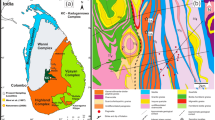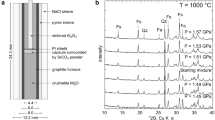Abstract
A unique sapphirine + orthopyroxene + quartz granulite from Mt. Riiser-Larsen in the Tula Mountains of Enderby Land, East Antarctica, preserves two generations of coarse and texturally equilibrated orthopyroxene and sapphirine coexisting with quartz. Initial subhedral orthopyroxene porphyroblasts retain core compositions enriched in Al2O3 (12.2 ± 0.5 wt%) compared with their rims and finer orthopyroxene (9.6 ± 0.5 wt% Al2O3) that forms granoblastic textures with sapphirine. Sapphirine and quartz also form symplectites on and along cleavage planes within orthopyroxene. These compositional and textural features are consistent with the reaction [2MgAl2SiO6=Mg2Al4 SiO10 + SiO2] leading to the formation of sapphirine + quartz at the expense of aluminous orthopyroxene. Calculations in the MAS and FMAS systems and theoretical considerations involving the phases enstatite, sapphirine, sillimanite, quartz and cordierite indicate that the reaction above progresses from left to right with decreasing temperature in the orthopyroxene + sapphirine + quartz field, at pressures of ca. 8–10 kbar. The temperature difference required to account for the ca. 2.5–3 wt% decrease in Al2O3 in orthopyroxene is at least 60–80 °C, and implies peak temperatures for the initial assemblage of at least 1120 °C if the second granoblastic assemblage equilibrated at 1040 °C, the P–T conditions required by the sapphirine + quartz association and other P–T-sensitive assemblage indicators in the Napier Complex. It is not possible to distinguish whether the two assemblages are simply related by cooling and re-equilibration or reflect a polyphase evolution involving the superposition of a second UHT event on an earlier, even higher temperature, UHT metamorphism. Preliminary thermodynamic modelling of the reaction above incorporating the observed range in orthopyroxene Al2O3 zoning indicates that present estimates for the entropy of high-temperature sapphirine are potentially too high by 15–18% compared with sapphirine entropy estimates that are consistent with MAS system experiments. The Mt. Riiser-Larsen sapphirine–quartz rocks preserve the first definitive record of regional metamorphic temperatures in excess of 1120 °C in the Napier Complex, or indeed any UHT granulite terrain worldwide. Similarly high peak temperatures may be retrieved from detailed studies of sapphirine–quartz granulites from other regions, further expanding the thermal realm of crustal metamorphism, but progress will critically depend on the experimental acquisition of new entropy data for sapphirine.
Similar content being viewed by others
Author information
Authors and Affiliations
Additional information
Received: 3 September 1998 / Accepted: 8 November 1999
Rights and permissions
About this article
Cite this article
Harley, S., Motoyoshi, Y. Al zoning in orthopyroxene in a sapphirine quartzite: evidence for >1120 °C UHT metamorphism in the Napier Complex, Antarctica, and implications for the entropy of sapphirine. Contrib Mineral Petrol 138, 293–307 (2000). https://doi.org/10.1007/s004100050564
Published:
Issue Date:
DOI: https://doi.org/10.1007/s004100050564




